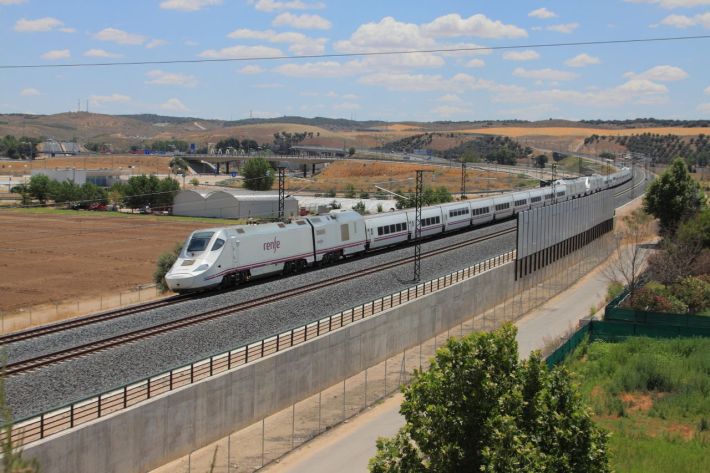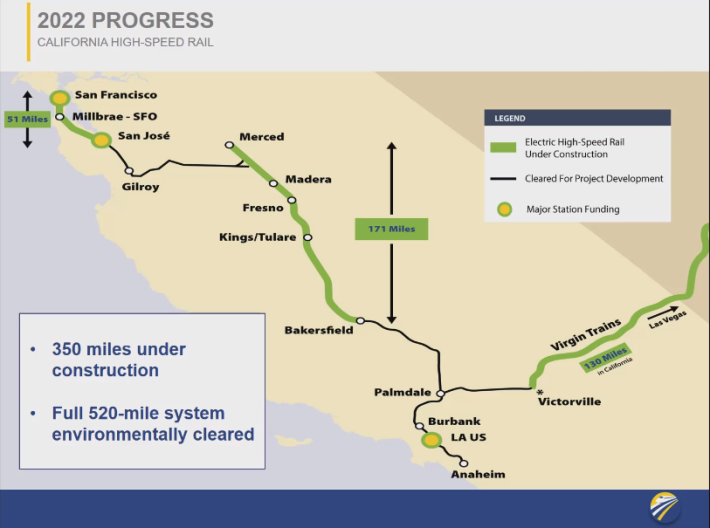Brian Kelly, current CEO of the California High Speed Rail Authority, was riding a train in 2013 from Madrid to Barcelona with a Caltrans official. The ride, which is only a bit shorter than the distance from L.A. to San Francisco, took two hours and thirty minutes. He remembers what the official said to him as they got off the train: "man we are so far behind, why is this option not available to California!” He recounted that during a talk about how to finish California's high-speed rail project at a Bay Area Council panel discussion Tuesday morning.
Indeed, California is far behind, in a state where cities such as Fresno and Bakersfield are isolated from the coastal economy and getting around involves expensive, slow, traffic-clogged four-to-six-hour drives or airport waiting lines. Kelly's job is to catch up with the Spanish, the French, the Germans, the English, the Japanese, the Chinese, the Koreans, the Italians, the Russians, and about 20 other nations and make emissions free, high-speed rail transport an option in California.

"It’s the right transportation choice in the era of climate change. It’s ultimately what we should strive for and get done," said Kelly.
But how? As laid out in a recent feature in The New York Times, the project has become a prime example of how in the U.S. petty, parochial politics seems to rip apart projects that other countries take for granted. California has become ground zero in the fight against entrenched, oil-funded interests who want to make sure Americans never experience fast, electrified high-speed rail.
Fortunately, thanks to the Obama Administration and the hard work of Governor Jerry Brown back in 2009, the project is well underway in the Central Valley. The key now is building political momentum for getting it finished. Former Secretary of Transportation Ray LaHood, who was also on the panel, said President Biden and Speaker Nancy Pelosi have already helped make sure billions in federal funds will be on tap. Meanwhile, the general population is getting a new incentive to want electrified, high speed rail. "People see gasoline prices soaring; they can save an awful lot of money getting on a train," said Lahood.
But how does one help the general population of California see what's possible, especially if they've never traveled on one of the world's high-speed rail systems? There has been so much disinformation spread to try and convinced people that high-speed rail either won't work in California or can never be completed. "You remember all the fallacies people said in the Central Valley?" said California Transportation Commission Chair Lee Ann Eager. "They even said the cow's milk will go sour!"
Of course, the dairy farmers of the Central Valley don't need to worry about trains messing with their cows. As Eager pointed out when she road high-speed rail in Europe through cow-pastures, the animals don't even look up when the trains pass. But short of flying everyone in California to Europe or Asia, the key, she said, is going to be getting that Central Valley segment running with trains, tracks and electrification so people can start to experience high-speed rail right at home--so they can see its transformational power, even if the system hasn't yet reached Los Angeles.

"I think it’s hard to get people to understand how it's different from Amtrak and what we have now," said Eager.
That's why while advocates are working on getting additional funds in Washington, Kelly is busy getting designs and planning and engineering done for the entire system. The strategy has always been to be ready for that change in sentiment when people start riding early phases of the system.

Kelly stressed that's one of the main reasons to push for electrification of the 170 mile Central Valley segment, long resisted by petroleum-backed politicians in both parties. "Why electrified HSR? One of the primary reasons is with the speeds electrification provides you can shrink the state. Instead of driving in four-plus hours from San Francisco to Fresno, you get there in an hour and 30 minutes. What today is a 12 or 13 hour train ride from SF to LA, we can do it in about 3 hours."
And shrinking the state means all sorts of opportunities for more commerce between the Central Valley, Los Angeles, and San Francisco. "The Bay Area and L.A. are international centers and the Valley is an agricultural powerhouse," said Kelly. "The reason we’re not bypassing the Central Valley is we're trying to connect these communities. We think that’s good for commerce, affordable housing, and just connecting the communities that are California."

But first they've got to get trains running at high-speeds.
"Transportation infrastructure has always been fraught with huge challenges," said HNTB Senior Vice President Darlene Gee, also on the panel. She reminded people that building a bridge across the Golden Gate channel was once incredibly controversial and problematic. But, of course, today if you asked "should the Golden Gate Bridge have been built" people would look at you as if you're completely nuts. Someday, that will be the case with high-speed rail in California, she said
Check out more talks from the Bay Area Council.





